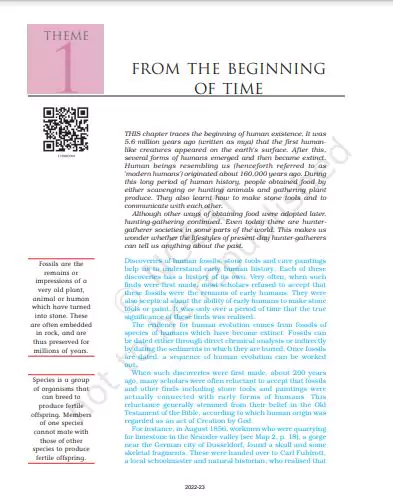‘NCERT Solutions for Class 11 History Chapter 1 From the Beginning of Time‘ PDF Quick download link is given at the bottom of this article. You can see the PDF demo, size of the PDF, page numbers, and direct download Free PDF of ‘Ncert Class 11 History Chapter 1 Exercise Solution’ using the download button.
From the Beginning of Time Textbook With Solution PDF Free Download

Chapter 1: From the Beginning of Time
THIS chapter traces the beginning of human existence. It was 5.6 million years ago (written as mya) that the first humanlike creatures appeared on the earth’s surface.
After this, several forms of humans emerged and then became extinct.
Human beings resembling us (henceforth referred to as ‘modern humans’) originated about 160,000 years ago. During this long period of human history, people obtained food by either scavenging or hunting animals and gathering plant produce.
They also learnt how to make stone tools and to communicate with each other. Although other ways of obtaining food were adopted later, hunting-gathering continued. Even today there are huntergatherer societies in some parts of the world.
This makes us wonder whether the lifestyles of present-day hunter-gatherers can tell us anything about the past.
Discoveries of human fossils, stone tools and cave paintings help us to understand early human history.
Each of these discoveries has a history of its own. Very often, when such finds were first made, most scholars refused to accept that these fossils were the remains of early humans.
They were also sceptical about the ability of early humans to make stone tools or paint. It was only over a period of time that the true significance of these finds was realised.
The evidence for human evolution comes from fossils of species of humans which have become extinct. Fossils can be dated either through direct chemical analysis or indirectly by dating the sediments in which they are buried.
Once fossils are dated, a sequence of human evolution can be worked out. When such discoveries were first made, about 200 years ago, many scholars were often reluctant to accept that fossils and other finds including stone tools and paintings were actually connected with early forms of humans.
This reluctance generally stemmed from their belief in the Old Testament of the Bible, according to which human origin was regarded as an act of Creation by God.
For instance, in August 1856, workmen who were quarrying for limestone in the Neander valley (see Map 2, p. 18), a gorge near the German city of Dusseldorf, found a skull and some skeletal fragments.
These were handed over to Carl Fuhlrott, a local schoolmaster and natural historian, who realised that they did not belong to a modern human.
He then made a plaster cast of the skull and sent it to Herman Schaaffhausen, a professor of anatomy at Bonn University.
The following year they jointly published a paper, claiming that this skull represented a form of human that was extinct.
At that time, scholars did not accept this view and instead declared that the skull belonged to a person of more recent times. The differences that you notice in the skulls shown in the illustration are some of the changes that came about as a result of human evolution.
The story of human evolution is enormously long, and somewhat complicated. There are also many unanswered questions, and new data often lead to a revision and modification of earlier understandings.
Let us look at some of the developments and their implications more closely. It is possible to trace these developments back to between 36 and 24 mya. We sometimes find it difficult to conceptualise such long spans of time.
If you consider a page of your book to represent 10,000 years, in itself a vast span of time, 10 pages would represent 100,000 years, and a 100 pages would equal 1 million years.
To think of 36 million years, you would have to imagine a book 3,600 pages long! That was when primates, a category of mammals, emerged in Asia and Africa.
Subsequently, by about 24 mya, there emerged a subgroup amongst primates, called hominoids. This included apes. And, much later, about 5.6 mya, we find evidence of the first hominids.
| Author | NCERT |
| Language | English |
| No. of Pages | 28 |
| PDF Size | 4.5 MB |
| Category | History |
| Source/Credits | ncert.nic.in |
NCERT Solutions Class 11 History Chapter 1 From the Beginning of Time
Question 1.
What do you know about Java men? Why did scientists call them “The Erect Ape Men”?
Answer:
The remains of Java men were first discovered by a Dutch surgeon in Java. It included-a skull, a thigh bone and two teeth.
The study of these remains depicts that the Java was half ape and half man. It is because his head (Java man’s head) was set forward of the neck. The Java men were also called “The Erect Ape Men” by the scientists because they could walk erect.
Question 2.
Who were Hominoids? When did they come into existence? Write their two unique characteristics.
Answer:
- Hominoids were the subgroup of primates.
- They came into existence about 24 mya.
Characteristics
- They had smaller brain.
- They were unable to walk erect.
Question 3.
Name two most important genus of Hominids. How they are different from each other?
Answer:
Two most important genus of Hominids are, Australopithecus and Homo.
The major differences between them can be identified by the size of their brain, jaws and teeth. It may be summed up as:
- Australopithecus have a smaller brain as compared to Homo.
- Australopithecus have also larger jaws and teeth as compared to Homo.
NCERT Class 11 History Textbook Chapter 1 From the Beginning of Time With Answer PDF Free Download
